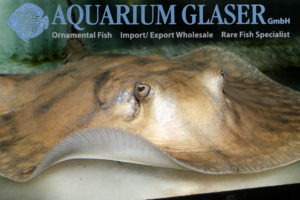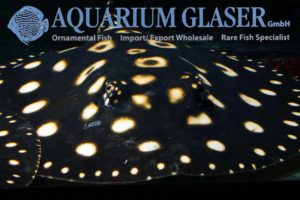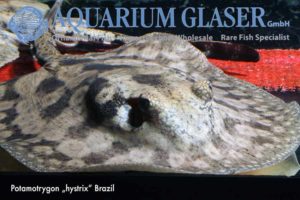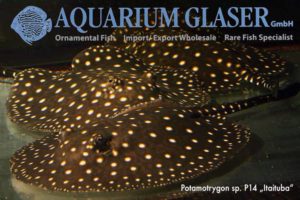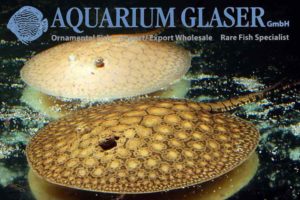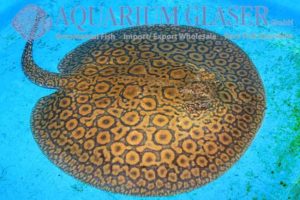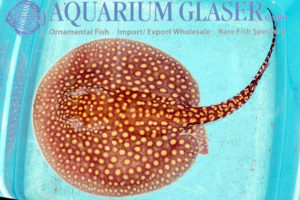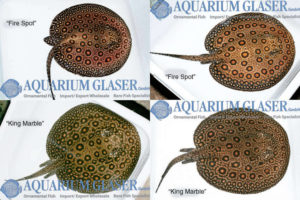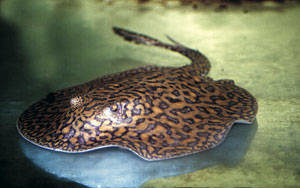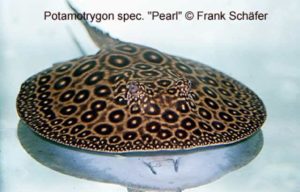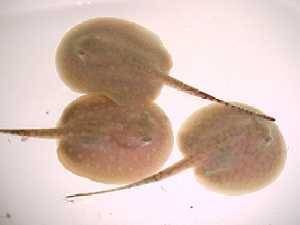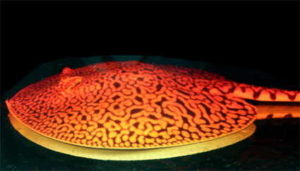For the first time we can offer a good number of German offspring of the freshwater stingray Potamotrygon orbignyi. Because of the extreme variability in colour this species, which was already scientifically described in 1855, is difficult to determine. The type specimen that Castelnau had at hand came from the Rio Tocantins in Brazil. As […]
01. Rays (14)
-
-
Potamotrygon wallacei
This freshwater stingray lives endemically in the Rio Negro system in Brazil and is or was the most often imported species of Potamotrygon from Brazil at all. However until recently they fish were wrongly identified as P. histrix, a different species that is not kept in aquaria at all and occurs in southern South America. […]
-
Potamotrygon leopoldi Black Diamond German Bred
We received extremely beautiful German bred Black Diamonds. Moreover the fish are sorted by pair! The Black Diamond is a variety of Potamotrygon leopoldi that originates from the upper Rio Xingu in Brazil. These splendid stingrays attain a maximum size of about 40-60 cm disc width. One should never forget that the poison of these […]
-
Potamotrygon
Funny enough: some of the most popular species of a group in the trade are often totally unknown to science! This is for example the case in P. “hystrix” from the Rio Negro basin in Brazil. This species stays comparatively small – around 30 cm disc width – and is thus quite popular in the […]
-
Beautiful P14/Itaituba, bred specimens
The taxonomy of the black river stingrays is very confusing. Three scientifically described species do exist: Potamotrygon henlei (described from the Rio Tocantins), P. leopoldi (described from the Rio Xingu), and P. garrapa (described from the Rio Branco). In P. henlei several varieties exist that possibly represent different, separate species. All specimens from the Rio […]
-
Potamotrygon scobina
We received German bred specimens of this comparatively small (about 35 cm disc width) freshwater stingray. The species is restricted – as far as known – to the Rio Tocantins in Brazil. For our customers: the animals have code 282012 on our stocklist. Please note that we exclusively supply the wholesale trade. Available in very […]
-
Potamotrygon sp.
We have received two beautiful stingrays from Peru which were collected in the Rio Ucuyali. Both specimens have a disc width of about 15-20 cm and are males. According to the grade of development of their sexual organs the species grows to a much bigger size. The fish do not fit any scientific description published […]
-
Potamotrygon cf. falkneri
Currently we have a great selection of wonderful river stingrays from Paraguay belonging to that species in stock. As in all river stingray species, each individual has its own colour pattern, which differs clearly from all other congeneers. This is one of the reasons why species can only be distinguished with great difficulties in Potamotrygon. […]
-
Great variety of freshwater stingrays available at Aquarium Glaser
The export stop of freshwater stingrays (Potamotrygon) has ended and so the very much sought after black species (P. henlei and P. leopoldi) are regulary available now again. Beside these Brazilian black rays we have astonishing Flower rays (P. schroederi) from Colombia and Venezuela, fantastic „King Marble”and Fire Spot” from Colombia (called P. motoro in […]
-
Potamotrygon sp. „Mantilla ray“
This freshwater ray originates from Paraguay. The multitude of forms and colours never stops to amazes one. In the past the scientific description of freshwater rays used to be done according drawings without any conserved specimens from natural museum history collections. The classifications of live animals by such limited descriptions are almost impossible to make.(Photo: […]
-
Potamotrygon sp. „Maracaibo Ghost“
The ghost of Maracaibo. So a novel by Gabriel Garcia Marquez could be named, here however it is about a newly imported ray. Few specimen of these with Potamotrygon yepezi related species reached us last week from Venezuela. There they inhabit muddy bank sections in shallow, clouded waters in the supplies of lake Maracaibo. They […]
-
Potamotrygon sp. „Pearl“
From one of the most sought – after of the Amazonian stingrays in the hobby, Potamotrygon sp. “pearl” we could offer first European bred offsprings. Pearl rays got their names for the repeating pattern of pearl-like spots within black rings covering its dorsum. Their origin is the Rio Tapajos where it share its biotopes with […]
-
stingray-babies
July 2005: During the night from Sunday to Monday it was about time: We got three babies. About five weeks ago we had received a female from Pantanal River and we immediately noticed on arrival that this fish was not alone: It was pregnant. After five weeks now of intensive care, these three babies were […]
-
Potamotrygon menchacai
September 2006: From Potamotrygon menchacai, the tiger stingray, we could import a big, very beautifully patterned, female animal with approximately 60 cm in diameter. Tiger-rays can be colored quite differently and particularly can differ in the contrast. Our tiger rays come from Peru, through size and scrutiny, they certainly are among the most impressive “ornamental-fishes.” […]






